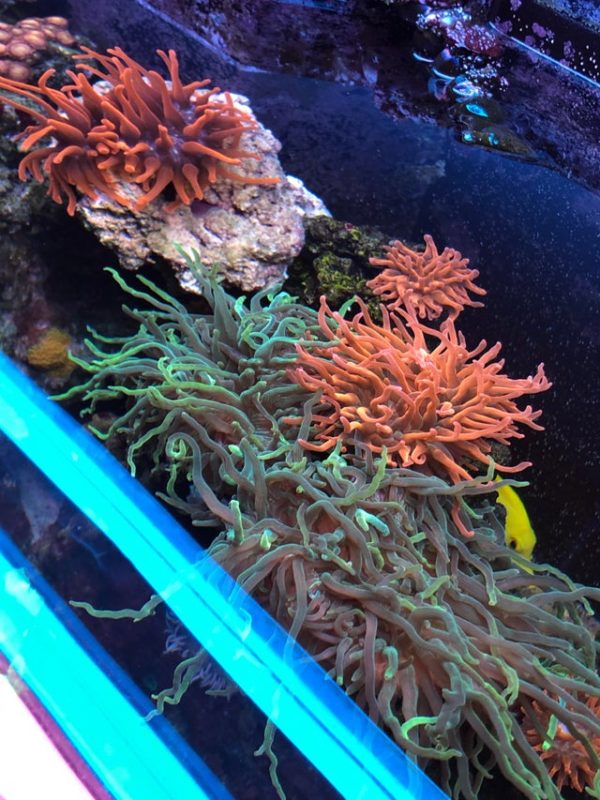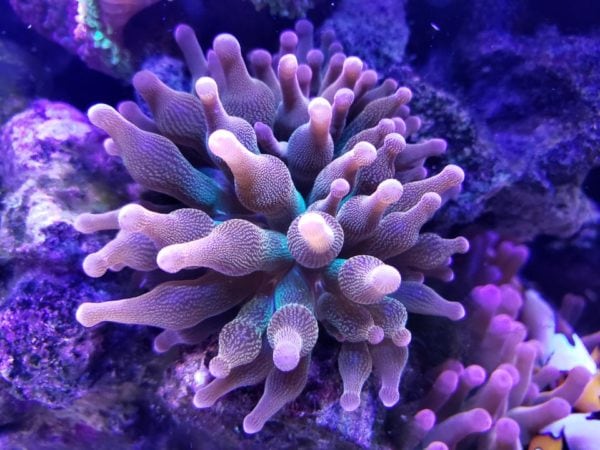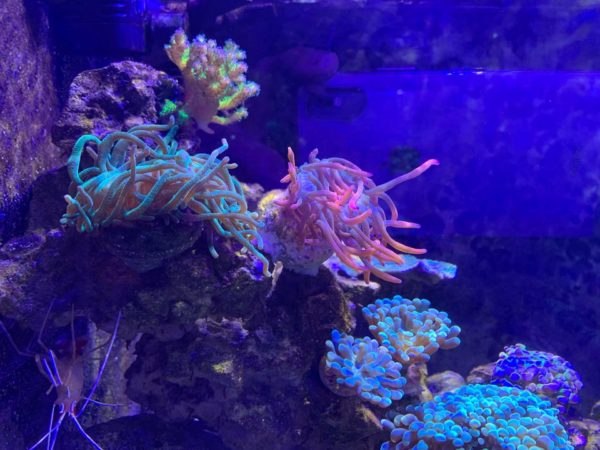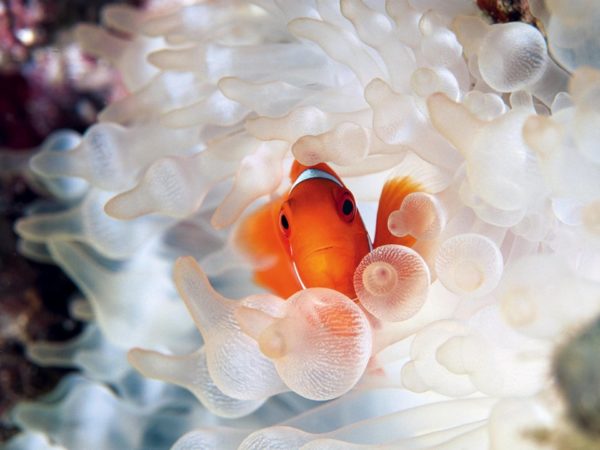In this guide, we explore the care and maintenance of Bubble Tip Anemones (BTAs) in home reef aquariums. BTAs, known for their vibrant colors and ease of care, form symbiotic relationships with clownfish and require a stable, well-established tank environment. Key aspects include appropriate tank size, stable water parameters, strong lighting, and regular feedings of meaty foods. BTAs exhibit unique characteristics, like bubble-like tentacles, and can live for many years with proper care. For beginners, BTAs present a manageable yet engaging challenge in reef aquarium hobbying.
Bubble tip anemones are some of the most popular animals among individuals that own a home reef aquarium. These beautiful animals come in many colors and tend to be easy to care for. They are also perfect symbiotes to have in a tank with clownfish.
Symbiotic relationships between organisms are common under the sea. And emulating these relationships in a tank at home is a challenge reef aquarium hobbyists love to tackle.
Building a reef tank with Bubble Tip Anemones can seem like a pipe dream, but it can be done if approached with patience and persistent effort.
This post covers everything you need to know about BTAs so you can build your dream coral reef tank without much hassle.
Table of Contents
Bubble Tip Anemone: A Quick Summary
Bubble tip anemones are a popular choice for saltwater aquariums due to their vibrant colors and unique, bubble-like tentacles. These animals require a well-established tank with stable water parameters and a strong light source. Bubble tip anemones also benefit from regular feedings of small pieces of meaty foods.
Bubble Tip Anemone Overview

Bubble Tip Anemones (BTAs) is an ideal for beginners in reef aquariums due to their moderate care level and ability to host clownfish. Characterized by colorful tentacles with bubble-like tips, these anemones vary in color and exhibit a semi-aggressive temperament. They can live over 100 years, reaching up to 12 inches in size. Originating from the Indo-Pacific Ocean, BTAs thrive in tanks with ample space, moderate lighting, and stable water conditions.
Bubble Tip Anemones (scientifically named “Entacmaea quadricolor”) are known to host several species of clownfish readily. These colorful creatures have tentacles that form pear-shaped enlargements below the tips. Sometimes, the tentacles aren’t swollen, resembling the tentacles of the Long Tentacle Anemone (Macrodactyla doreensis).
BTAs don’t require precise lighting parameters to survive and do not require sophisticated supplemental feeding to survive. This makes them the go-to anemone for new hobbyists. That said, these creatures tend to move around a lot and need ample space in the tank to thrive.
| Information Chart | Bubble Tip Anemone |
| Scientific Name | Entacmaea quadricolor |
| Family | Actiniidae |
| Care Level | Moderate |
| Temperament | Semi-aggressive |
| Color | Typically tan, brown, green, and bluish-green. It can also be cream pink, red, brick red, and rose pink. |
| Lifespan | 100+ years |
| Size | Up to 12 inches |
| Up to 12 inches | Carnivorous |
| Minimum Tank Size | 50 gallons |
| Temperature | 72.0° F to 83.0° F |
| Water Conditions | Moderate hardness |
| Moderate hardness | Moderate hardness |
Bubble Tip Anemone Appearance
BTAs have interesting bulb formations on the tips of their tentacles, which makes them stand out from other species of anemone.
Scientists have still not found the cause for these pear-shaped formations on their bodies. Some researchers speculate that the bubbles form on their tentacles because they require more lighting. Others guess that the bulbs are needed because they need more food.
BTAs come in several colors, but they’re typically tan, brown, green, or bluish-green.
These animals can also sometimes have a pink, red, or brick red color. Bubble Tip Anemones with a rose pink body are rare and go for higher prices than BTAs of other colors.
Another distinguishing attribute of BTAs is the pedal column with a sticky foot at the bottom. They use this foot to stick to surfaces and move to other areas if conditions are not ideal.
Typically, the pedal column is brown and has small bulges (verrucae) with stinging cells. In addition, the pedal column may have lines, flicks, and spots on it, and the bumps may be of different colors, with white, orange, and yellow being most common after brown.
Some BTAs have larger bubbles than others, which tend to shrink in low lighting conditions.
Types of Bubble Tip Anemone
Bubble tip anemones come under the Actiniaria family, which can further be divided into forty-six families. What’s more interesting is that they are one of over a thousand species that share similarities with coral and jellyfish.

Sometimes considered oceanic flowers, these creatures have the best of both worlds. Their polyp attaches to a basal disc, and their body extends outward surrounding their oral disc, similar to corals. They also have tentacles with nematocysts – just like jellyfish do.
Besides having different colors, they exhibit two variations depending on where they thrive. Large colonies of smaller BTAs are found in shallow waters. On the other hand, larger, solitary BTAs are found in deeper waters.
Both of these varieties have specific species of clownfish living in the same area and depth.
While the two varieties can come in very different sizes, they aren’t considered different species because of the change in size.
Lifespan of Bubble Tip Anemone
The typical lifespan of a Bubble Tip Anemone is 80 years in captivity.
These anemones can live for hundreds of years in the wild; however, their average lifespan in aquarium settings is unknown.
Bubble Tip Anemone Size
The average Bubble Tip Anemone typically grows up to 12 inches on the lower end and 20 inches for larger specimens.
They can have tentacles up to two inches long when stretched out. Therefore, it is critical to have a big tank for a BTA to grow and move around. Having more than two large BTAs in one large tank isn’t a good idea.
Natural Habitat and Origin
Rüppell and Leuckart first described the Bubble Tip Anemone in 1828. The scientists classified the species under the Entacmaea genus and Actiniidae family.
These creatures are found in the Indo-Pacific Ocean – between the Red Sea and Samoa. They are common and are not on the IUCN Red List for endangered species.
BTAs can be found at depths of 130 feet in intertidal zones. They typically bury their pedal column into crevices, quickly retracting into them if they feel threatened. They share a symbiotic relationship with clownfish, wherein the Clownfish provides food and the BTA provides protection.
Bubble Tip Anemone Care & Tank Set-Up

Proper care and tank setup for Bubble Tip Anemones (BTAs) require a stable, mature aquarium environment. BTAs thrive in tanks with strong lighting, consistent water parameters, and ample space. Regular feedings with meaty foods and careful monitoring are essential. It’s important to avoid sudden changes in the tank environment to ensure the health and longevity of BTAs.
Setting up the right environment for the anemones to grow is critical for their survival. BTAs of different sizes require different amounts of space and different types of care.
Bubble Tip Anemone Tank Size and Specifications
Optimum Tank Size for Bubble Tip Anemone
The recommended tank size for Bubble Tip Anemone is a 100-gallon tank with live rock for a 12” specimen. The tank must be at least 9-12 months old.
If you have a juvenile BTA two inches in size, you can put it in a 30-gallon tank. A four-inch specimen requires a 50-gallon tank, and if it is between six and eight inches in length, you will need a 75-gallon tank.
If the specimen is larger than 12”, you will need to get a bigger tank.
Nano tanks are unsuitable for Bubble Tip Anemones since it can be challenging to maintain the water quality as it grows bigger.
Tank Shape for Bubble Tip Anemone
There are no restrictions when it comes to the shape of the tank. Most reef aquariums are rectangular, but you can get a tank in a shape that appeals to you.
Filter Type
We recommend avoiding using filters in reef tanks since they can be difficult to clean. Filters of all kinds also don’t perform at the same level as sumps do. Since sumps hold more water, they help keep the water parameters more stable, which is critical for the anemone’s health.
It is also vital to ensure that any pumps in the tank remain covered to prevent damage since BTAs move around and get stuck on the pumps and cut their foot.
Substrate
You can put any type of substrate in your tank. However, bear in mind that Bubble Tip Anemones bury their pedal columns into the crevices of rocks.
If you have sand in your tank, make sure you put coral branches into it so the anemone can attach to it.
How Many Bubble Tip Anemones In 100-Gallon Tank?
You can have one large 12-inch BTA in a 100-gallon tank. You can put two smaller four-inch anemones in the tank, but you will need to move the two into a bigger tank as they grow larger.
If you want two large anemones, you will need at least a 300-gallon tank so they can move around and co-exist.
After you place an anemone in a tank, it will move to a spot where it’s most comfortable. The species typically settles in the middle or top regions of the aquarium – wherever it finds the light to be adequate.
If it’s happy with the food and light it gets, it will generally stay put.
However, the species is known to wander about in tanks even if it is happy. Unless the mouth is open and gaping, the Bubble Tip Anemone is not stressed or unhappy.
Water Parameters for Bubble Tip Anemone
Besides getting the right tank, you will need to continually ensure that the water’s parameters are appropriate for your anemone’s growth.
Water Temperature
The ideal water temperature for Bubble Tip Anemones ranges between 72.0° F to 83.0° F.
You can use submersible thermostat heaters to control the temperature of the water in the tank. To cool down the water rapidly, you can use ice packs. But be careful not to change the temperature of the water too quickly.
Water Flow Rate
BTAs require moderate amounts of water flow to thrive. Experts argue that if the flow is too heavy, the anemone will stretch out. On the other hand, if the flow isn’t heavy enough, they will retain the bubble shape on their tentacles.
You can control the water flow rate using wavemakers. You can buy them online and in local stores. It is essential to get the covers for these devices to protect your anemones.
pH Level
The perfect water pH level for Bubble Tip Anemones ranges between 8.1 and 8.4. Anemones thrive when kept in large tanks with a lot of water. Keeping the flow and pH right will ensure that your BTA grows and reproduces optimally.
Water Hardness
The hardness level of the water is just as critical to the growth of Bubble Tip Anemones as the pH level, temperature, and water flow. Therefore, you must work to maintain a water hardness of between 8 and 12 dKH.
You can use demineralized water and water softeners to control the hardness and acidity of the water in your tank.
Bubble Tip Anemones Tank Landscape
Setting up aqua spaces is a matter of personal taste. When setting a tank up for Bubble Tip Anemones, remember that they like crevices to hide their foot and need moderate to high amounts of light to thrive.

Besides that, you can set up the tank as you like. Some plants do better with BTAs in the tank than others, and for your convenience, we’ve shortlisted the best and worst plants to have in the tank.
Best Plants for Bubble Tip Anemone Tanks
Some of the best plants to add to any saltwater aquarium include:
- Green finger algae
- Spaghetti algae
- Seagrass
- Mermaid’s fan
- Halimeda
Decorations for Bubble Tip Anemone Tanks
BTAs can thrive in standard aquarium setups. However, they require live rock to anchor themselves in place and grow comfortably. Therefore, adding a typical amount of live rock to the tank will help the anemone thrive.
Adding any other decorations should not create a problem. However, you must make sure that your tank doesn’t get too crowded. Besides live rocks, buying a quality protein skimmer will help ensure your BTA remains healthy in the tank.
Lighting for Bubble Tip Anemone Tanks
Bubble Tip Anemones need moderate to high lighting to remain healthy. If your tank has lower light than the BTA wants, it will move to the middle of the tank. Too much light and the BTA will move to the area in the tank with the least light.
Getting a light that outputs between 220 and 350 PAR is the right way to go.
Nitrogen/Other Nutrient Requirements for Bubble Tip Anemone Tank
You must maintain low amounts of iodine, phosphate, and nitrate in the tank. However, ammonia and nitrite must not be detected.
Feeding Bubble Tip Anemone
A healthy and comfortable BTA has a mouth that’s closed tightly. The mouth only opens up when it’s hungry, and it has an oval shape.
If you see that your Bubble Tip Anemone has a gaping mouth, it is a warning sign – feed it immediately. You must remember that the species eats and expels waste from the same opening.
Best Diet for Bubble Tip Anemone
Bubble Tip Anemones are carnivores and capture food with their tentacles. They have nematocysts on their tentacles, just like jellyfish do, which they use to sting and eat their prey.
In the wild, their daily nutrition comes from symbiotic algae that dwell on them. Besides that, BTAs absorb clownfish waste.
In tanks, they must be fed chopped worms, mussels, shrimp, silversides, fish, and krill. They can also eat frozen carnivorous foods.
How Often Should You Feed Bubble Tip Anemone?
Bubble Tip Anemones should typically be fed meat at least two times a week. However, BTAs can be fed four times a week at the most to supplement photosynthesis.
If you have a clownfish in the tank, you will need to feed your anemone once or twice a week at the most.
Juveniles must be fed daily but will find reef roids sufficient.
Bubble Tip Anemone Behaviour and Temperament
Anemones can be aggressive and venomous, but Bubble Tip Anemones are considered the right species for beginners. However, that brings forth the question:
Are Bubble Tip Anemone Lone Or Societal In Nature?
Putting anemones of any type in a reef environment is not recommended since corals cannot move away from their stinging tentacles.
If you have a Bubble Tip Anemone that hasn’t move for several months, adding some corals may be safe. However, you must make sure you put the corals on rocks that you can move, in case the anemone decides to wander.
Anemones can live with other anemones in the tank. However, they need to be at least two-three feet away. If they are too close, the chemical exchange will lead to one of the two shrinking and dying.
Having two Bubble Tip Anemones shouldn’t be much hassle if you have a large tank (at least 100 gallons) and excellent filtration. However, they must be positioned at opposite ends of the tank, and you must place a physical barrier so they don’t wander into each other’s spaces.
If you want to have two anemones in your tank, it is best to get them young and let them grow bigger in the same tank.
Bubble Tip Anemones Tank Mates
Bubble Tip Anemones (BTAs) can coexist with a variety of tank mates in a reef aquarium. They are particularly compatible with clownfish, which form a symbiotic relationship with them. BTAs can also share a tank with other peaceful fish and invertebrates that don’t pose a threat. However, care should be taken to avoid housing them with aggressive species that might harm them. A harmonious tank environment is key for the well-being of BTAs and their companions.
Finding tank mates for a BTA shouldn’t be challenging. They can host over 13 species of clownfish.

Ideal Bubble Tip Anemones Tank Mates
In the wild, Bubble Tip Anemones can host 13 Clownfish species:
| Fish | Scientific Name |
| Clark’s Clownfish | Amphiprion clarkia |
| Amphiprion clarkia | A. frenatus |
| Australian Clownfish | A. rubrocinctus |
| Three-Band Clownfish | A. tricinctus |
| Allard’s Clownfish | A. allardi |
| Barrier Reef Clownfish | A. akindynos |
| Two-Band Clownfish | A. bicinctus |
| Maroon Clownfish | Premnas biaculeatus |
| Oman Anemonefish | A. omanensis |
| Red Saddleback Clownfish | A. ephippium |
| Orange-fin Clownfish | A. chrysopterus |
| Red and Black Clownfish | A. melanopus |
| McCulloch’s Clownfish | A. mccullochi |
Besides these fish, you can also add the Ocellaris Clownfish, snails, urchins, Frogspawn Corals, sand dollars, copepods, amphipods, and mini brittle stars in the tank with your BTA.
If you decide to add sea slugs or nudibranchs, make sure you add reef-safe species into the tank. While flatworms, bristle worms, and feather dusters are safe to keep in the tank with a BTA, they must be out of reach of the anemone.
You must ensure that the BTA is three to four times as large as the fish if you’re adding Clownfish. Also, you must let the BTA acclimate to the tank for a few months before adding a clownfish.
Bad Tank Mates for Bubble Tip Anemone
Crabs are a threat to BTAs, so you should never add them to the tank. In addition, bubble Tip Anemones are may be aggressive towards corals, making it critical to keep them out of reach of the anemone.
Further, you must keep other anemones, button polyps, sea mats, starfishes, clams, oysters, and scallops out of reach of the BTA.
Breeding Bubble Tip Anemone
BTAs undergo binary fission for reproduction. The ethical way of breeding Bubble Tip Anemones is to let them grow and split up naturally. Feeding the BTA more frequently will accelerate growth and subsequent splitting.
However, some breeders prefer cutting the BTA with a sharp blade or scissors to “clone” them. When split, each piece must have a mouth, pedal disc, and oral disc, and none of the parts must be damaged.
Bubble Tip Anemone Breeding Level
- Intermediate
Bubble Tip Anemone Sexual Dimorphism?
There is no way to distinguish between male and female Bubble Tip Anemone.
Bubble Tip Anemone Common Diseases and their Treatment
After a Bubble Tip Anemone settles in, it shouldn’t have any problem unless the lighting isn’t sufficient or the quality of water and water flow is inadequate.
If your anemone moves a lot, it is unhappy. Changes in color and shape of the BTA further indicate a problem in either the light, water, or both.
Other anemones, nudibranchs, bristle worms, sea stars, angelfish, triggerfish, and large wrasses are known to sometimes attack Bubble Tip Anemones.
If you have non-reef fish in your tank, you must keep an eye out for attack marks.
Facts About Bubble Tip Anemone
- BTAs can host Clownfish but will kill other fish.
- Damage/tearing of an anemone’s foot can lead to death.
- BTAs rarely fall sick. However, they are affected by changes in water and lighting.
- Bubble Tip Anemones should never be given large chunks of food since it can be hard for the creature to break it down.
- Bubble Tip Anemone prey on corals. Great care must be taken of the coral if a coral is in the same tank as a BTA.
- Bubble Tip Anemones can reproduce rapidly, especially under stress. If you find that your tank is crowded only after a few weeks of having the BTA in it, look into improving lighting and water quality.
Are Bubble Tip Anemones Right For You?
If you’ve never owned an aquarium before, getting a Bubble Tip Anemone isn’t right for you. You must have some experience with caring for fish to care for a BTA correctly.
Author’s Note: A Bubble Tip Anemone may look shriveled up one day only to be blooming the next day. You don’t have to be worried about your BTA dying unless it is continually shriveled up and has changed color.
Frequently Asked Questions
Can I touch my Bubble Tip Anemone?
Wearing gloves is recommended when handling a BTA since they can sting you. The sting will burn and hurt, but it is not lethal.
Why did my Bubble Tip Anemone lose its bubbles?
The bubble shape disappears from the tentacles if the BTA isn’t being fed correctly or is living in the wrong lighting conditions. Feeding it silversides thrice a week or changing the lighting should solve the problem.
Why do Clownfish live in BTAs?
BTAs provide the Clownfish with protection and shelter, while Clownfish’s wastes provide the Bubble Tip Anemone with the nutrition it needs to survive.
Conclusion
If you’re getting into reefing as a hobby, holding off buying an anemone for at least six months is crucial.
Once the tank has a stable nitrogen cycle, you can go ahead and safely buy anemones for it. This takes at least six months, and waiting up to a year before adding any anemone is recommended.
It is also critical for you to inspect anemones before you buy them. If the anemones at your local fish store look shriveled up, stink, or look like they’re falling apart, avoid buying them.
You must also remember to inspect the foot of the anemone you want to buy. If there is a tear on the BTA’s foot, there’s a chance it wasn’t cut properly and will need to be nursed back to good health.
No related posts.
